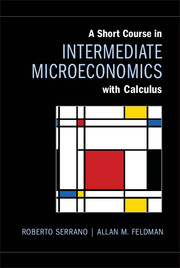Book contents
- Frontmatter
- Contents
- Preface
- 1 Introduction
- Part I Theory of the Consumer
- 2 Preferences and Utility
- 3 The Budget Constraint and the Consumer's Optimal Choice
- 4 Demand Functions
- 5 Supply Functions for Labor and Savings
- 6 Welfare Economics 1: The One-Person Case
- 7 Welfare Economics 2: The Many-Person Case
- Part II Theory of the Producer
- Part III Partial Equilibrium Analysis: Market Structure
- Part IV General Equilibrium Analysis
- Part V Market Failure
- Index
5 - Supply Functions for Labor and Savings
from Part I - Theory of the Consumer
- Frontmatter
- Contents
- Preface
- 1 Introduction
- Part I Theory of the Consumer
- 2 Preferences and Utility
- 3 The Budget Constraint and the Consumer's Optimal Choice
- 4 Demand Functions
- 5 Supply Functions for Labor and Savings
- 6 Welfare Economics 1: The One-Person Case
- 7 Welfare Economics 2: The Many-Person Case
- Part II Theory of the Producer
- Part III Partial Equilibrium Analysis: Market Structure
- Part IV General Equilibrium Analysis
- Part V Market Failure
- Index
Summary
Introduction to the Supply of Labor
In addition to creating the demand for goods and services, individuals also supply key factors of production to firms. In particular, they supply their labor, and, by saving, they supply capital (i.e., money) to producers. In the first part of this chapter we study the decisions involving consumption and leisure, which are behind the supply of labor. We model the standard budget constraint for the consumption/ leisure choice, which involves the wage rate, consumption, and the time spent working versus the time spent on leisure. We also model some special budget constraints, for example, those involving nonlabor income. We analyze the effects of income taxation on the consumer's labor/leisure choice. This analysis has some very interesting implications about the relative desirability of flat and progressive income taxes.
We then turn to the consumer's decisions regarding the supply of savings. We discuss borrowing and saving, and revisit intertemporal budget constraints such as the ones introduced in Chapter 3. Savings flow through the financial system and end up (hopefully) as part of the capital used by firms to produce more goods and services. We model the consumer's savings decision, and show how the amount the consumer saves depends on the interest rate and the inflation rate, as well as on the timing of the consumer's income stream.
Information
- Type
- Chapter
- Information
- Publisher: Cambridge University PressPrint publication year: 2012
